

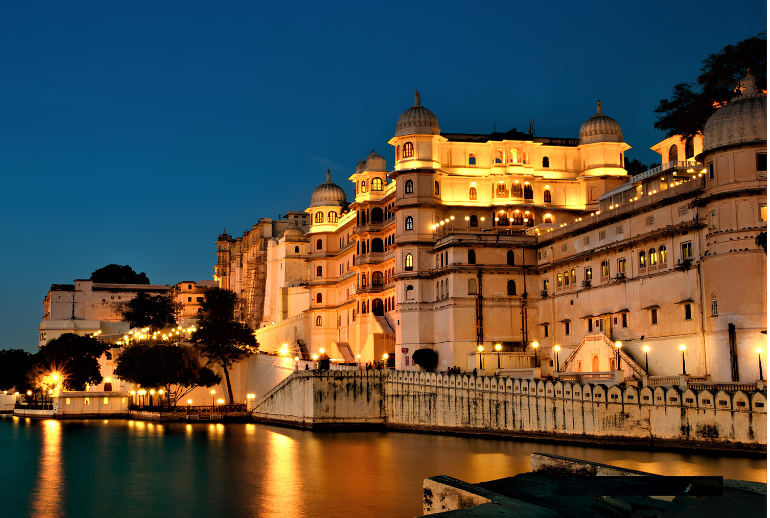
Rajasthan, the Royal State of India, is known as the regal home of the great Indian Maharajas who have managed to maintain their traditional splendour. In the heart of the Thar, the chivalrous rulers of Rajasthan are still alive in the various folklores and folk songs that narrate the evergreen legends of their bravery and romance. The glory is well preserved in the people of Rajasthan and in the majestic forts and palaces. Braving the unmerciful desert winds and oppressing heat of the scorching sun, they have stood invincible against many-a-sieges and have provided refuge to the rulers in their time of strife. Now, they have been opened to the tourists who come here to see a wonderful display of their rich heritage and splendid artistic architecture. Many of these forts and palaces retain their old charm and tradition. Some of the royal residences have been now turned into heritage hotels, where the visitors can still experience the magic of India's regal past.
Rajasthan is rich in architecture and is a delight for all kinds of tourists with its sandy dunes, mighty forts, lush blossoming gardens, shimmering lakes and outstanding monuments. The medieval zeal of honor among the Rajputs rings true in Chittorgarh Fort, men and women alike, while the romantic reverie hovers over the island palaces of Lake Pichola. One can almost see the shy royal ladies chuckling to see the royal procession on the roads of Jaipur, unseen and safe behind the screens of Hawa Mahal. The religious fervor of the staunch devotees at Dargah Sharief at Ajmer and Shrinath ji at Nathdwara is no less than the grandeur of City Palace of Jaipur and astronomical wonders of Jantar Mantar. We present here a list of the top favorite tourists' places that are not worth a miss in this land of wonders
Ajmer is bustling city, located 130 km southwest of Jaipur and just 14 km from the pilgrimage town of Pushkar. The city of Ajmer gets its name from “Ajay Meru”, which can be roughly translated as “invincible hill”. Home to a number of tourist places, Ajmer can be a perfect representation of the diversity of the Indian culture and ethics, and displays a perfect blend of religion, community, culture, etc., coexisting and flourishing in harmony.


Anasagar Lake is a scenic artificial lake, commissioned and built by Arnoraj Chauhan, son of Ajaypal Chauhan, between 1135 and 1150 AD. Arnoraj was also known as Anaji, which gives the lake its name. Many years later, Mughal Emperor Jahangir added his touch to the lake by laying out the Daulat Bagh Gardens near the lake. Emperor Shah Jahan too, contributed to the expansion by building five pavilions, known as the Baradari, between the garden and the lake.
According to Hindu scriptures, the sacred Pushkar Lake is described as ‘Tirtha Raj’, the king of all pilgrimage sites. No pilgrimage is considered to be complete without a dip in in the holy Pushkar Lake. Semi-circular in shape and about 8-10 metres deep, Pushkar Lake is surrounded by 52 bathing ghats and over 400 temples and is truly a magnificent sight to behold.
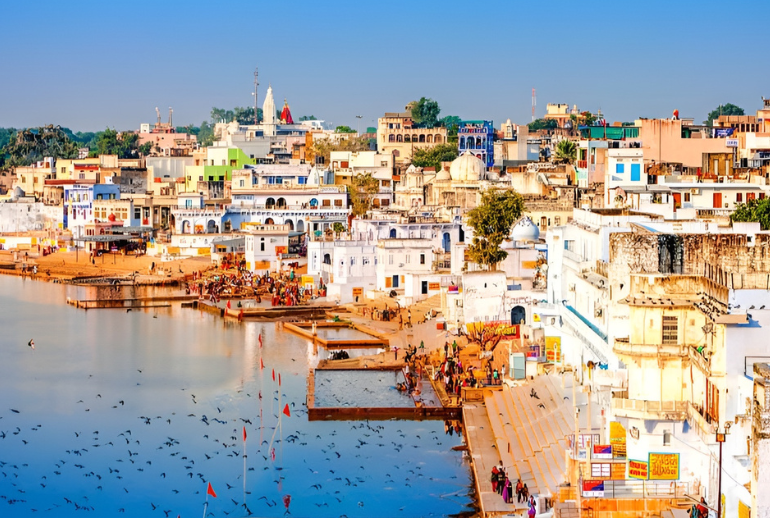
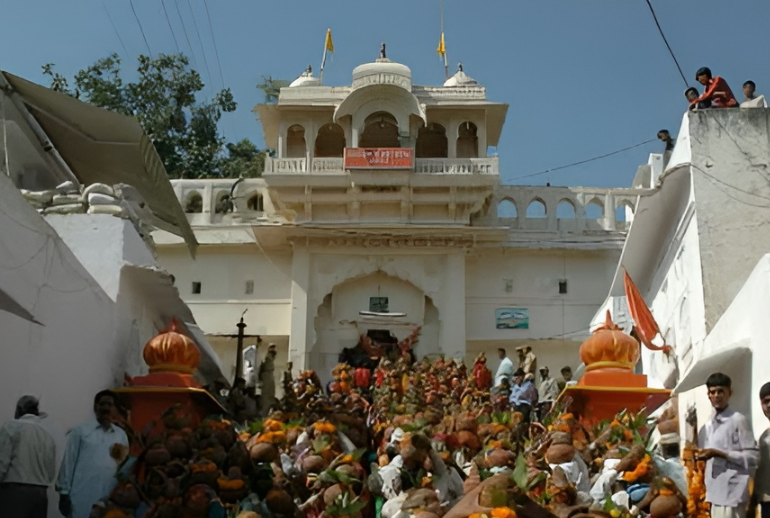
Nestled in the picturesque Pushkar valley beyond the Nangaparvat and Anasagar Lake, the Brahma temple holds a special place in the hearts of Indians. It is the only temple in the world dedicated to Lord Brahma. Built with marble and decorated with silver coins, this temple can be identified by its red spire and the image of a swan (considered sacred to Lord Brahma). The chaturmukhi (four faced) idol of Lord Brahma is housed in the inner sanctum. A marble statue of the sun god stands sentinel at the temple. Interestingly, while all the gods are shown bare footed, Surya is shown wearing ancient warrior’s boots.
Kishangarh Fort is a beautiful fort located in Kishangarh, Rajasthan. On visiting the fort, one will see jails, granaries, armouries and other significant buildings present inside of it. The Durbar Hall is its biggest structure, and was the place where the kings carried out their official meetings on a daily basis. And when it comes to the most attractive place inside the fort, it has got to be Phool Mahal which showcases the splendour of the kings from the Rathore clan in a glorious manner, with gorgeous murals and frescos adorning its walls. Alongside the fort, a few lakes like Gundu lav talab & Hamir Sagar are located which serve as a great picnic spot. If you want to revisit history, Kishangarh Fort is a place you ought to visit when in Rajasthan. Near by Kishangarh one can also see Nimbark Peeth & Chor Baori -Salemabad(20Km.), Roopangarh(25Km.), Ruins of Karkeri fort and Cenotaphs of Shri Jawan Singh-Karkeri (30Km. via Salemabad), Group of old Makbaras-Tukda(7 Km.), Tilonia (20 Km.) ,Pitambar Ki Gaal-Silora (7 Km.) & Ruins of old Palace or Sarai- Chatari .


The marble slurry dump yard is an unconventional place to visit, the sights there are stunning. It’s odd that a landfill appears beautiful and precise. Pre-wedding and fashion photo shoots are extremely popular there, and the scenery is similar to that of Ladakh.
Jodhpur, the second largest city in Rajasthan is popularly known as the Blue City. The name is clearly befitting as most of the architecture – forts, palaces, temples, havelis and even houses are built in vivid shades of blue. The strapping forts that tower this magnificent city sum up to a spectacle you would not want to miss. The mammoth, imposing fortress of Mehrangarh has a landscape dominating a rocky ridge with the eight gates leading out of the fortress. The new city is located outside the structure. Jodhpur is also known for the rare breed of horses known as Marwari or Malani, which are only found here
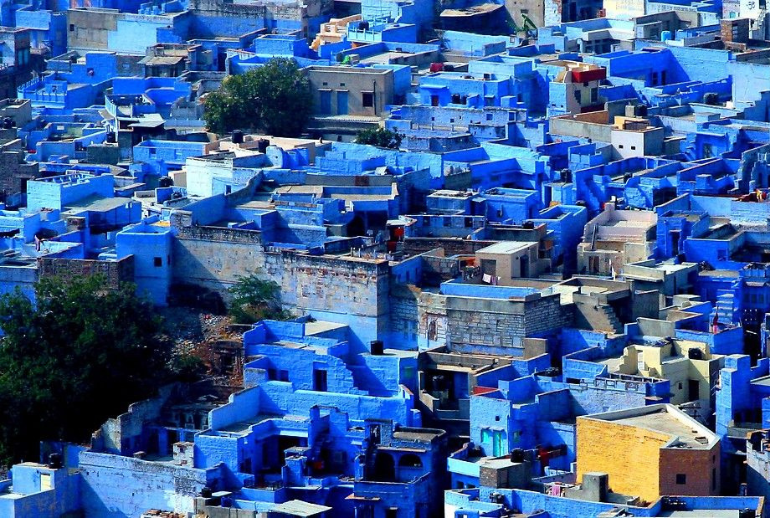
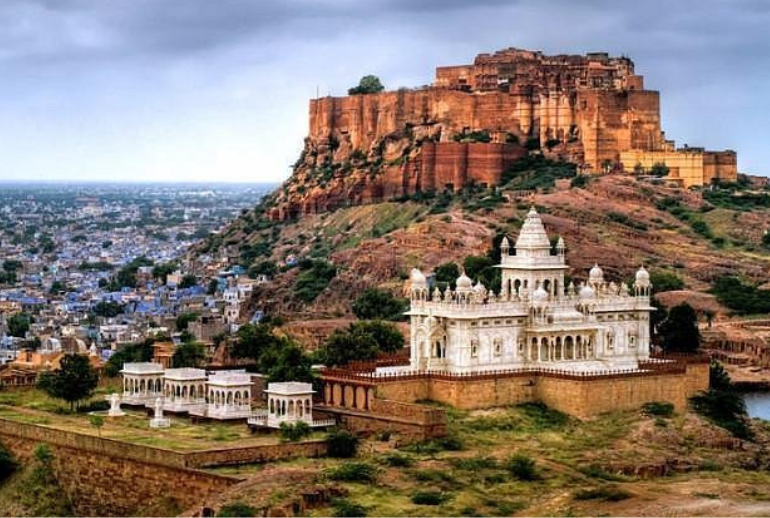
Rising perpendicular and impregnable from a hill which is 125 metres above Jodhpur’s skyline is the Mehrangarh Fort. This historic fort is one of the most famous in India and is packed with history and legends. Mehrangarh Fort still bears the imprints of cannonball attacks courtesy the armies of Jaipur on its second gate. Chiselled and sturdy, the fort is known for its exquisite latticed windows, carved panels, intricately decorated windows and walls of Moti Mahal, Phool Mahal and Sheesh Mahal.
Umaid Bhawan Palace was built by Maharaja Umaid Singh in 1929 to counter a famine which had hit the state at the time. It was also known as the Chittar Palace while being constructed thanks to the use of stones drawn from the Chittar hill. The palace was designed by HV Lanchester, a renowned British architect, and was completed in 16 years. Built with sandstone and marble, the architecture of the palace is described as a blend of lndo-Saracenic, Classical Revival and Western Art Deco styles. It is recognised as one of the largest private homes in the world and also one of the more spectacular buildings. It is the only palace built in the 20th century.


This milky white memorial built towards the end of the 19th century as a tribute to the leader Jaswant Singh is a huge tourist attraction. Jaswant Singh, who ruled Jodhpur, invested well in his state. He made attempts to bring down the level of crime, subdue dacoits, built railways and broadly worked on raising the economy of Marwar. Jaswant Thada is managed and looked after by the Mehrangarh Museum Trust (MMT) and is open to public. The Trust is operating a Museum in Jaswant Thada displaying portraits of Marwar rulers along with informative didactics – the information serves as orientation space to understand the history of Marwar through the Portraits. Its grounds serve as a serene venue for morning concerts during music festivals such as the Rajasthan International Folk Festival and the World Sacred Spirit Festival.
If geology interests you, then Jaisalmer is where you need to journey. The Wood Fossil Park or Aakal is located about 15 kilometres away from the city. Here, one can discover and trace geologic tragedies that occurred in the Thar Desert 180 million years ago. The city of Jaisalmer also acts as the guard to western Rajasthan (and India’s) frontier. This 'Golden City’ is located close to the Pakistan border and in close proximity to the Thar Desert. The city’s most prominent landmark is the Jaisalmer Fort, also called Sonar Qila (Golden Fort). Unlike most other forts in India, Jaisalmer Fort is not just a tourist attraction. It houses shops, hotels and ancient havelis (homes) where generations continue to live.


Jaisalmer Fort The Jaisalmer Fort also goes by the name Sonar Quila (Golden Fort) as it rises from the desert itself and seems to become one with the golden hues of the sand. The setting sun adds its own magic and shrouds the fort with mystique. The fort is constructed in the classic style of the royals by local craftsmen. This fort is a world heritage site and forms an important plot point in one of Satyajit Ray’s famous Feluda stories and corresponding movie, Sonar Kela (The Golden Fortress).
Gadsisar Lake was constructed in the 14th century by Maharawal Gadsi Singh to meet the water needs of his arid lands. Considering its importance, many small temples and shrines were constructed around it, transforming it into a pilgrimage centre and a tourist attraction.

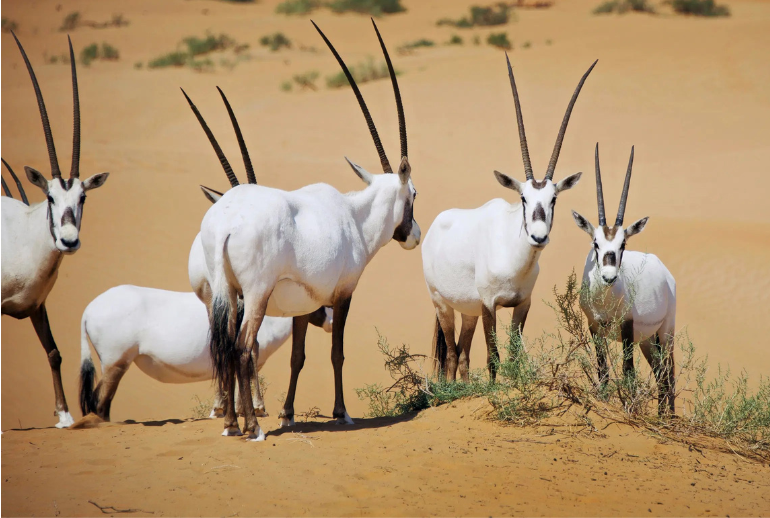
The Desert National Park displays the best of the Thar desert’s ecosystem and its varied wildlife. The Park is formed of undulating sand dunes, jagged rocks, dense salt lake bottoms and inter-medial areas. Various species of animals such as black buck, chinkara and desert fox inhabit the Park. The highly endangered Great Indian Bustard, one of the world's heaviest flying birds, can also be seen here. In winter, the park hosts an incredible variety of migratory raptors such Himalayan and Eurasian Griffon Vultures, Eastern Imperial Eagle, and the Saker Falcon.
The underlying history of Kuldhara has piqued the curiosity of one visitor too many, and makes it one of the most enigmatic destinations to visit in Jaisalmer, Rajasthan. The story has a beautiful daughter, an unscrupulous minister, scared villagers, an exodus in the middle of the night, and no idea where the villagers vanished. This is not the story of a movie, but the unfathomable legend that lies behind the abandoned village of Kuldhara. Located about 18 km from the city of Jaisalmer is this old town that was abandoned by its villagers in the 1800s. It was like the entire town vanished in the course of a single night. With about 85 villages full of people, it remains a mystery as to how no one saw them leave; in fact, even to this date, no one knows where all of them went either. The village remains uninhabited to the day, in the same state that the villagers had left it, hundreds of years ago. The location has become a major tourist destination as people from all over the world travel here to revel in the mysteries of the past. The desolate outline of Kuldhara etches a story in front of your eyes, if you are keen enough to read it!
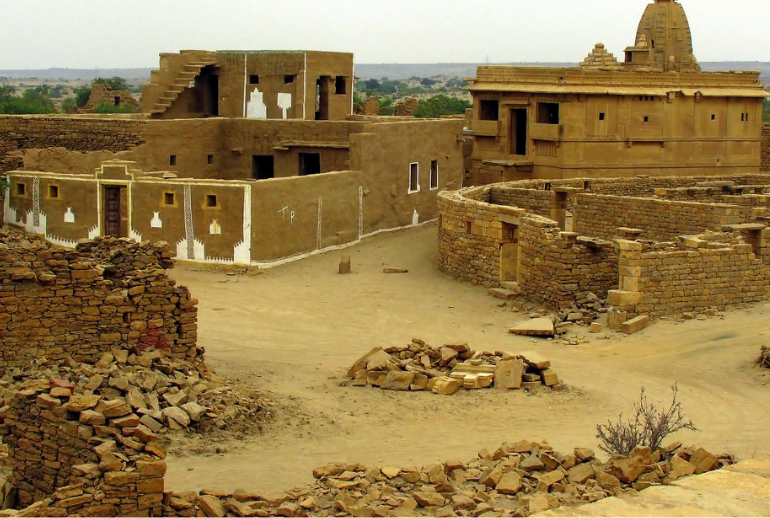
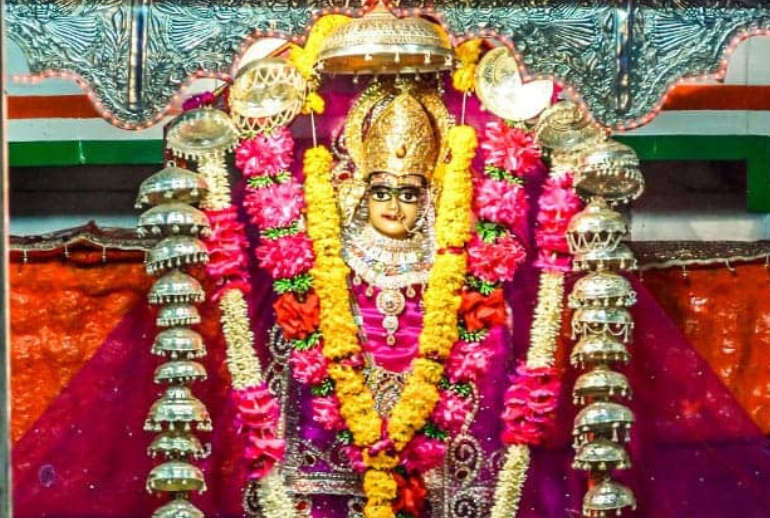
Some 120 kilometres away from Jaisalmer is the Tanot Mata Temple. Tanot Mata is considered to be a reincarnation of Goddess Hinglaj. There are many stories of how during the 1965 India-Pakistan war, Tanot was under heavy attack and shelling. However, none of the shells or bombs fired at the temple exploded. This reaffirmed people’s faith that Goddess the temple. Post the war, the Border Security Force (BSF) rebuilt the temple and today, the temple is managed by a BSF Trust.
Sam sand dunes, is one of the most authentic desert dune site in whole India, where you will find 30-60 meter tall sand dunes, and many travelers enjoying Desert Safari on camels or jeep, Sam is 45 km west from Jaisalmer city, where you can reach by hiring a can from Jaisalmer city and then stay in one of many desert camps, built in 2-3 km radius of sand dunes.
The best time to reach Sam sand dunes is around evening (sunset) at around 4-7 PM or early morning, during sunrise time of 4 to 6 am. You can book a camel or jeep (which is available at desert camps) to reach.the sunset point, that is 20-30 minutes from the campsite.
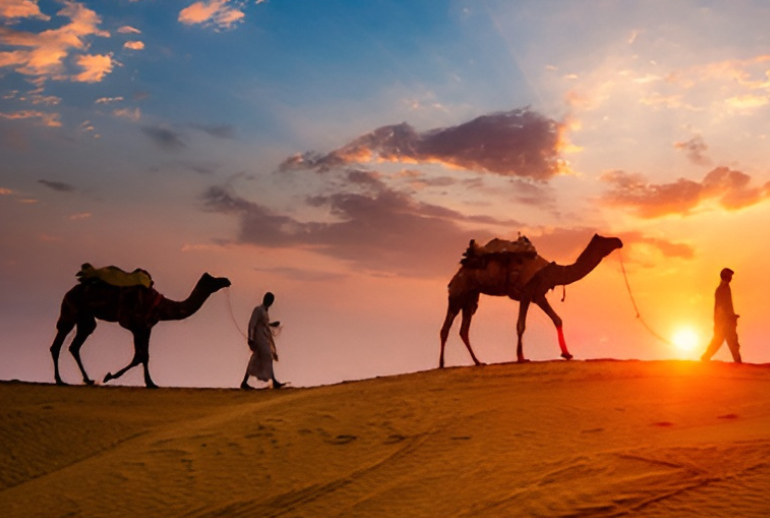

Often referred to as the 'Venice of the East', the city of lakes Udaipur is located around azure water lakes and is hemmed in by lush green hills of Aravallis. The famous Lake Palace, located in the middle of Lake Pichola is one of the most beautiful sights of Udaipur. It is also home to Jaisamand Lake, claimed to be the second largest man-made sweet water lake in Asia. The beautiful City Palace and Sajjangarh (Monsoon Palace) add to the architectural beauty and grandeur of the city. The city is also known for its profusion of zinc and marble. Solar observatory in Lake Fateh Sagar is the only observatory in India located on an island and has been made on the pattern of Big Bear Lake in Southern California. The ten-day Shilpgram Festival which starts from 21 Dec to 30 Dec pulls in a large number of people interested in arts and crafts.
Udaipur was founded in 1553 by Maharana Udai Singh II as the new capital of Mewar Kingdom. It is located in the fertile, circular Girwa Valley to the southwest of Nagda, which was the first capital of Mewar.
A majestic architectural marvel towering over the lake on a hill surrounded by crenelated walls, it is a conglomeration of courtyards, pavilions, terraces, corridors, rooms and hanging gardens. The main entrance is through the triple arched gate, the "Tripolia" with eight marble porticos, The Maharanas were weighed under the gate in gold, the equivalent amount of which was distributed among the populace. The surajgokhada, the balcony of the sun, is where the SuryanshiMaharanas of Mewar presented themselves to the people in the time of trouble to restore their confidence. The 'MorChowk' known for its exquisite peacock mosaics in glass and the 'ChiniChitrashala' noted for its blue and white ceramics are other attractions in the palace. A high tech sound and light show is conducted every evening at the magnificent ManakChowk which brings alive the rich history of Mewar.


Now a hotel but was originally called Jagniwas and served as a summer palace. Built between 1743 and 1746 on the island near Jagmandir in Lake Pichola, the palace, which faces east, is a wondrous sight to behold. The walls made of black and white marbles are adorned with semi-precious stones and ornamented niches. Gardens, fountains, pillared terraces, and columns line its courtyards.
Situated just outside Udaipur, this 19th-century palace is built on top of Bansdara hills. Used as a monsoon palace and hunting lodge, its builder, Maharana Sajjan Singh, originally planned to make it an astronomical center. The plan was cancelled with Maharana Sajjan Singh's premature death. It is still an awe-inspiring sight on the Udaipur skyline and offers spectacular views of the city and the areas around.
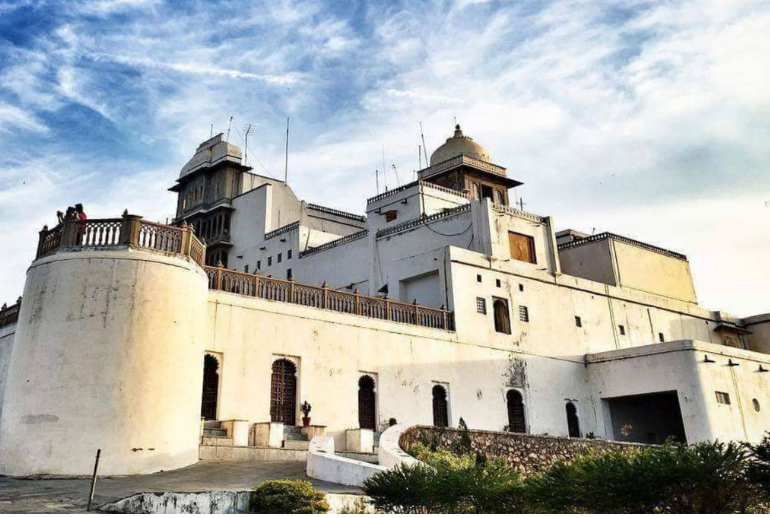
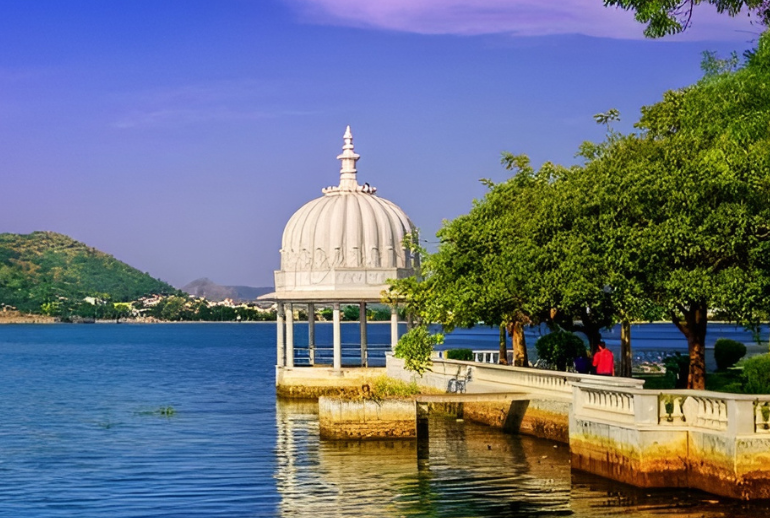
This delightful lake, bordered by hills and woodlands, lies to the north of Lake Pichola. This artificial lake is connected to Lake Pichola by a canal. The lake houses the beautiful Nehru Island as well as an islet on which stands the Udaipur Solar Observatory. It was inaugurated by the Duke of Connaught and was initially called Connaught Bundh.
Picholi was the name of a village that lent its name to the lake. The islands of Jagniwas and Jagmandir are housed in this lake. Along the eastern banks of the lake lies the City Palace. A boat ride in the lake around sunset offers a breathtaking view of the Lake and City Palace.

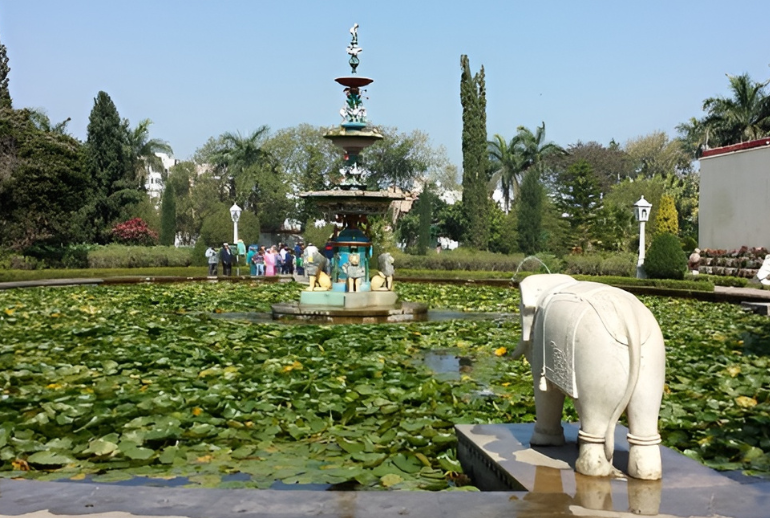
Built by Maharana Sangram Singh II as a garden for women, Saheliyon-ki-Bari or the Garden of the Maidens is a popular tourist destination. Along with a small museum, it has several attractions such as marble elephants, fountains, kiosks and a lotus pool.
Jaisamand Lake is known for being the second largest man-made sweet water lake in Asia. It is popular among the locals as a weekend picnic destination. Locals say that the lake was constructed to halt the waters of Ruparel River. This lake boasts of a large island, which is home to various species of birds, at its centre.

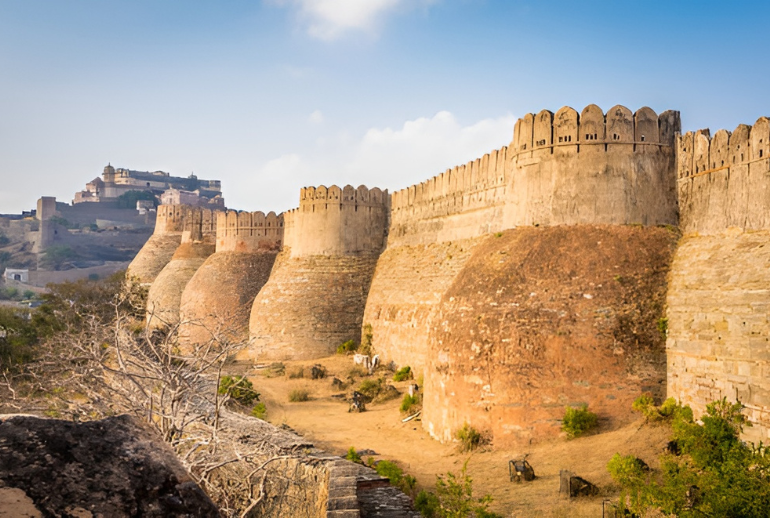
BIRTHPLACE OF MEWAR'S LEGENDARY KING, MAHARANA PRATAP. Located 84 kms north of Udaipur in the wilderness, Kumbhalgarh is the second most important citadel after Chittorgarh in the Mewar region. Cradled in the Aravali Ranges the fort was built in the 15th century AD by Rana Kumbha. The inaccessibility and hostility of the topography lends a semblance of invincibility to the fort. It served the rulers of Mewar as a refuge in times of strife. The fort also served as refuge to King Udai of Mewar in his early childhood when Banbir killed Vikramaditya and usurped the throne. It is of immense sentimental significance for the people being the birthplace of Mewar's legendary king Maharana Pratap. The fort is self-contained in all respect to withstand a protracted siege. Its defences could be breached only once by the combined armies of the Mughal and of Amber primarily for scarcity of drinking water. There is a magnificent array of temples built by the Mauryas of which the most picturesque place is the Badal Mahal or the palace of the clouds. The fort also offers a superb bird’s eye view of the surroundings. The fort's massive wall stretches some 36 kms with a width enough to take eight horses abreast. Maharana Fateh Singh renovated the fort in the 19th century. The fort's large compound
While it is difficult to arrive at the exact date the fort was established, legend has it that the construction of the Chittorgarh Fort was initiated by Bhim, a Pandava hero from the mythological epic Mahabharata. The fort houses several magnificent monuments, some unfortunately ravaged by time.
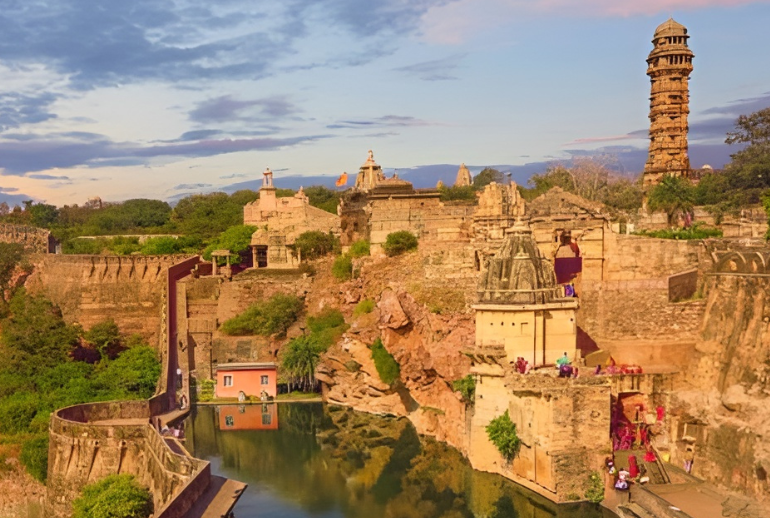
.jpg)
Serving as a source of comfort from the sultry dessert climate of Rajasthan, Mount Abu, the state’s only hill station stands at a height of 1722 metres above sea level, and is embraced by lush green hills of the Aravalli range.
Studded with a colourful mix of rustic abodes of tribal communities and posh houses inclusive of British style bungalows and royal holiday lodges, Mount Abu appears to be no less than a wonder in this dessert state. Covered in vast stretches of green forests, serene lakes, and effusive waterfalls, this region allows you to revel amidst panoramic vistas, all year round.
Other than its scenic beauty, Mount Abu is also popular as a seat of religious importance for Jains. The structural architectural wonders in Mount Abu, among other places to visit, have been drawing history buffs and architecture enthusiasts from different corners of the world.
Recognized as the first ever manmade lake in India, Nakki Lake is also a preferred place to see in Mount Abu. You can choose to take a boat ride at the lake and watch the sun set past the beautiful hills surrounding this place. Nakki Lake is also popular for being the place where the ashes of Mahatma Gandhi had been immersed. Toad rock, a place for sightseeing in Mount Abu is located close to Nakki Lake.
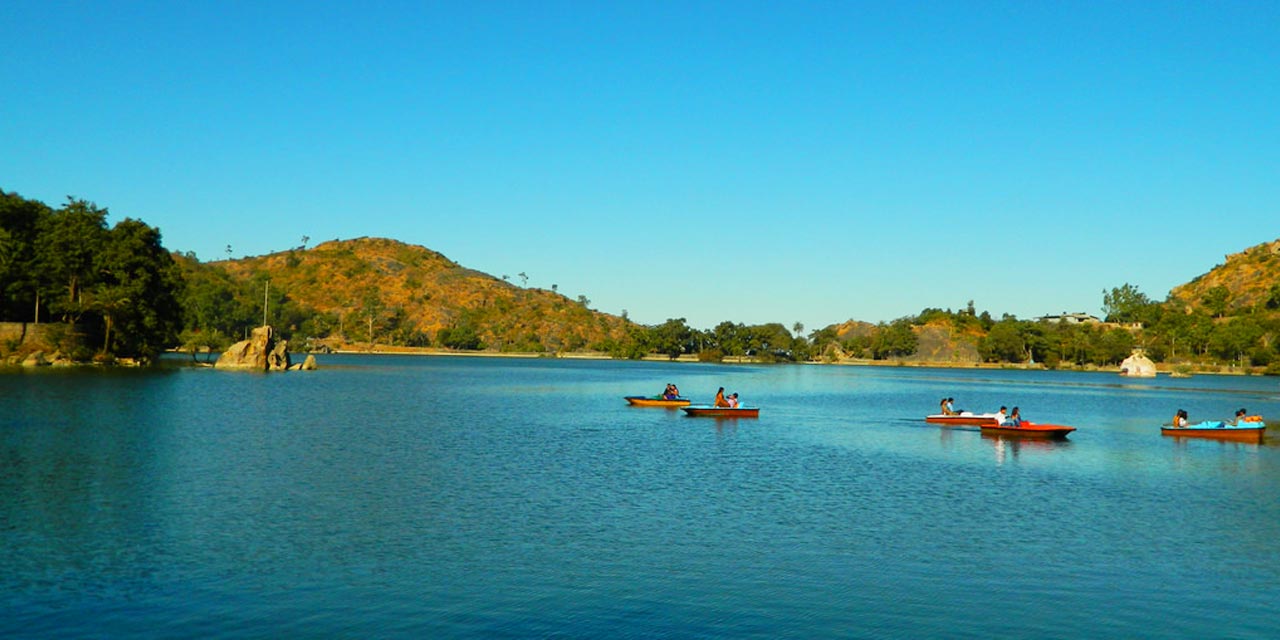

Recognized as the highest point on this mountain range, Guru Shikhar is an exquisite place for sightseeing in Mount Abu. Taking about 300 steps up to Guru Shikhar, you reach the temple of Guru Dattatreya, an incarnation of the Divine Trinity (Brahma, Vishnu and Shiva). People flock to this place both for its religious aspects and the panoramic views.
Established some time in between the 11th and 13th centuries, the Dilwara Jain temples are considered to be among the best specimens of architectural perfection in the country. A complex of five temple structures, the Dilwara Jain temples are located at a distance of about 2.5 kilometres from Mount Abu. Carved out of white marble, these temples features interiors that have intricate designs spreading everywhere from doorways to ceilings. Dilwara Jain temples are a must visit place in Mount Abu.


Bikaner is home to one of the only two models of the biplane used by the British during World War I. They were presented by the British to Maharaja Ganga Singh, then ruler of the city. Another unique aspect about Bikaner are the sand dunes that are scattered throughout the district, especially from the north-east down to the southern area. Bikaner is situated in the northern region of Rajasthan. One of the earlier established cities, Bikaner still displays its ancient opulence through palaces and forts, built of red sandstone, that have withstood the passage of time. The city boasts of some of the world’s best riding camels and is aptly nicknamed ‘camel country’. It is also home to one of the world’s largest camel research and breeding farms; as well as being known for having its own unique temple dedicated to Karni Mata at Deshnok, called the Rats Temple.
The origins of Bikaner can be traced back to 1488 when a Rathore prince, Rao Bikaji, founded the kingdom. Legend has it that Bikaji, one of Rao Jodhaji’s five sons, left his father’s Durbar in annoyance after an insensitive remark from his father, the illustrious founder of Jodhpur. Bikaji travelled far and when he came upon the wilderness called Jangladesh, he decided to set up his own kingdom and transformed it into an impressive city.
Junagarh is an impregnable bastion that holds the distinction of having never been captured. It was constructed in 1588 AD by Raja Rai Singh, one of Emperor Akbar’s most distinguished generals. The fort complex houses some magnificent palaces constructed in red sandstone and marble and visitors can feast their eyes on an attractive assortment of courtyards, balconies, kiosks and windows.
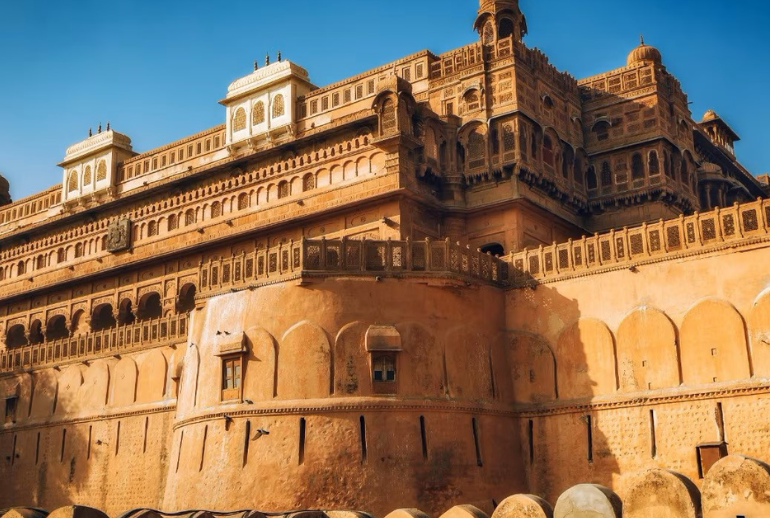
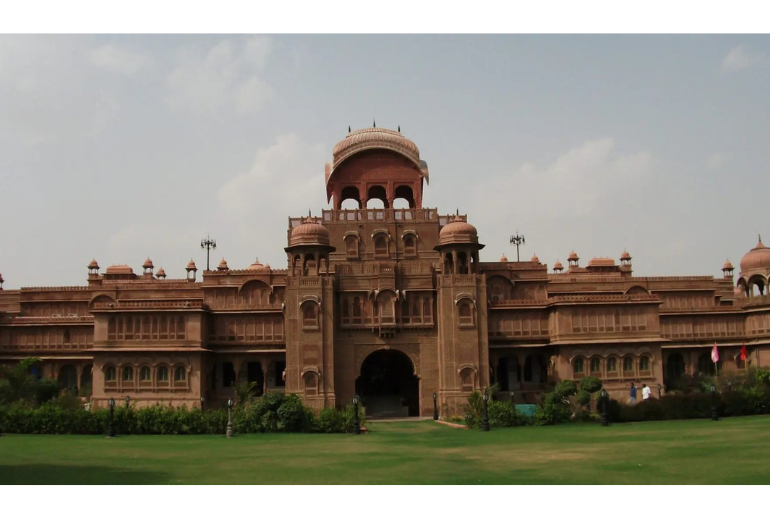
Maharaja Ganga Singh commissioned the construction of this majestic palace. This architectural marvel is made entirely of red sandstone and was built in 1902 to commemorate his father, Maharaja Lal Singh. The design was conceptualised by Sir Swinton Jacob, who created this oriental fantasy by blending Rajputana, Islamic and European architecture.
The Karni Mata Temple at Deshnok is a beautiful structure made of stone and marble, inside which resides an image of Karni Mata. The image is decorated with a ‘mukut’ (tiara) and garlands. The images of her sisters and the sisters of Avad Mata give her company on either side. The temple is known the world over for the presence of kabas (rats) that roam freely within the temple precincts


The history of Bharatpur dates back to 5th century BC, when the Matsya kingdom flourished here. The Matsyas were allies of the Pandavas in the Mahabharata war. Legends say that the origin of the name Bharatpur is traced to Bharat, younger brother of Lord Ram. Laxman, the other brother, was given the most prestigious position as that of the family deity of the ruling family of Bharatpur. His name also appears in the state seals and coat-of-arms.
In the early 18th century, Maharaja Suraj Mal captured the fort of Bharatpur by vanquishing Khemkaran, the rival chieftain and laid the foundation for Bharatpur. The valiant Maharaja was very keen to expand the cities and is credited with building the numerous forts and palaces that dot the kingdom, including the Pleasure Palace Complex at Deeg.
Bharatpur is also home to one of the world's best-known bird watching destinations, Keoladeo Ghana National Park (KNP). 250 years ago, the then ruler built embankments that allowed flooding of this land, turning it into a marsh. Named after the dense jungle that surrounded an old Shiva Temple, this 29 square kilometre man-made wetland is renowned for migratory birds – ducks, geese, waders, raptors, flycatchers and more. In winter, avid birders and ornithologists flock to the park to observe and study the feathered beauties. With more than 370 recorded species, KNP used to also host the Siberian crane. It is a World Heritage Site.
Every year, thousands of migratory waterfowl birds such as green sandpiper and cranes visit the park during winter. It was created in mid 18th century as a small reservoir located 5 kilometres to the southeast of Bharatpur. The construction of the Ajan Bund (dam) and the subsequent flooding of this natural depression led to one of the world’s most fascinating and spectacular bird reserves. The Keoladeo Ghana National Park is considered to be one of the richest bird areas in the world today.

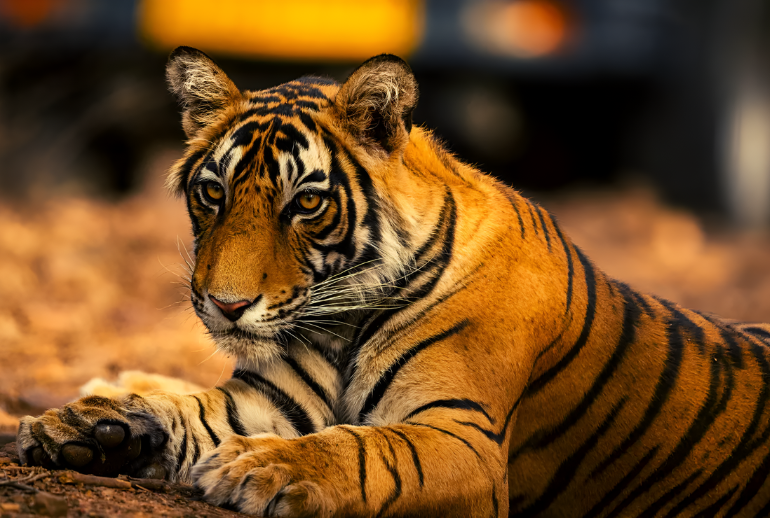
Cuddled up in the eastern zone of Rajasthan, Sawai Madhopur is one of the prominent conurbations of Rajasthan. Popularly known as the 'Gateway to Ranthambore', the town has seen many historic episodes and reigns. Sawai Madhopur has partly plain and partly undulating hilly terrain. The South and south east part of the district has hills and broken ground which form a part of a vast track of rugged region enclosing the narrow valley of the Chambal river. Surrounded by Vindhyas & Aravalis, this place is a treat for adventure enthusiasts as well as the ones with a fascination for history, with the Ranthambore National park- the most renowned national park in northern India and the Ranthambore Fort which was recently included in the list of UNESCO’s World Heritage sites, being the main attractions.
The noteworthy Ranthambore Fort was built by the Chauhan rulers in the 10th century. Due to its strategic location, it was ideal to keep the enemy at bay. The fort is also related to the historical legend of the royal women performing ‘jauhar’ (self-immolation) when the Muslim invader Alauddin Khilji laid siege on this fort in 1303. The fort is characterised by temples, tanks, massive gates and huge walls.

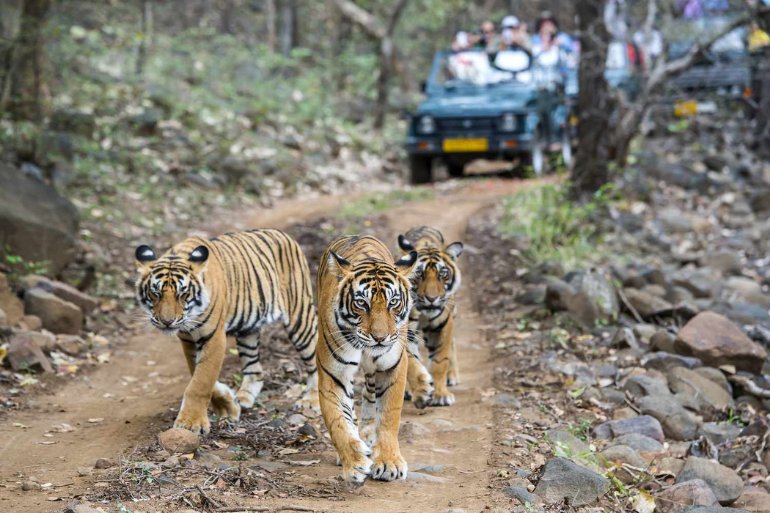
Situated 14 km from Sawai Madhopur, the Ranthambore National Park gets its name from the Ranthambore Fort situated within its boundaries. The National Park, situated amidst the Aravalis and Vindhya ranges is spreads over an area of 392 sq.km of thick forest punctuated with pleasant waterfalls. It is home to the elusive tiger, other animals found here include chinkara, sambhar, cheetal and over 300 species of birds.